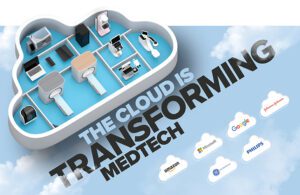
[Illustration via Adobe Stock]
Leaders in medtech and cloud computing discuss payoffs and potential in device connectivity, product development and cross-industry partnerships.
If knowledge is power, that power comes from a steady stream of information, and we know there’s no shortage of that in healthcare.
The challenge has long been how to capture that information, store it, analyze it and deploy it to improve medical product design, manufacturing and the health of patients.
Then came the cloud, and with it a host of acronyms: software as a service (SaaS), platform as a service (PaaS), infrastructure as a service (IaaS), and — following the same convention — software as a medical device (SaMD).
Over the past few months, Medical Design & Outsourcing connected with leaders in medtech and cloud computing, including the three largest providers of cloud computing services: Amazon (Nasdaq: AMZN), Microsoft (Nasdaq: MSFT) and Google (Nasdaq: GOOGL). They offered examples of success stories in the cloud, ways the cloud can lift medicine to new heights, and some advice for medtech insiders looking to harness the power of cloud computing.
The following excerpts have been edited for space and clarity.
MDO: What are some surprising and inspirational examples of what cloud computing enables with regard to medical device design, manufacturing and capabilities/performance?

Alissa Hsu Lynch [Photo courtesy of Google]
Alissa Hsu Lynch, Google Cloud global lead for medtech strategy and solutions: Researchers at Emory University used Google Cloud to create an algorithm that uses 71 factors to predict the onset of sepsis in patients within four to six hours with 85% accuracy, improving the time to diagnosis. [On another front], DeepMind’s AlphaFold machine learning system recently helped solve the protein structure problem, which has been a grand challenge in biology for 50 years. Research organizations can now leverage AlphaFold to better understand complex diseases and accelerate the development of new treatments, such as life-saving cures that disproportionately affect poorer parts of the world.

David Rhew [Photo courtesy of Microsoft]
Dr. David Rhew, Microsoft global chief medical officer and VP of healthcare: Sensoria makes a boot for diabetics to track pressure and movement and a variety of things, allowing us to pull all that data into the cloud and apply advanced analytics and AI to potentially predict pressure ulcers. We can think of putting sensors of any type on any device you wear or implant in your body. From there, the question is what do you do with the data? And that’s where artificial intelligence and machine learning can come in.

Taha Kass-Hout [Photo courtesy of Amazon]
Dr. Taha Kass-Hout, Amazon Web Services chief medical officer and director of machine learning: Ambra Health used AWS to expand its software as a service medical imaging data platform to five new countries in order to meet strict data security requirements. Butterfly Network is an innovator with Butterfly iQ, one of the first handheld whole-body ultrasound systems that uses AWS for making medical imaging universally accessible and affordable, providing a personalized experience for healthcare providers at drastically lower cost.

Roshy Francis [Photo courtesy of GE Healthcare]
Roshy Francis, GE Healthcare life care solutions chief technology officer: The pandemic overwhelmed hospital systems, and patient complexity has increased with multiple comorbidities. These dynamics require multi-specialty care teams to collaborate to make timely and accurate decisions in acute care settings. Clinical care teams can now virtually come together around a patient, with a complete picture of the patient from various systems, without having to be physically present at the bedside. We have deployed solutions on the cloud that help ensure care protocol compliance in the ICU and Labor & Delivery for timely interventions that lead to improved patient outcomes. We are now deploying solutions that allow complex procedures like anesthesia delivery to be monitored and guided by experienced anesthesiologists remotely.
MDO: What are some previously unthinkable advances that now seem increasingly likely to become reality?

Larry Jones [Photo courtesy of Johnson & Johnson ]
Larry Jones, Johnson & Johnson group CIO and global vice president of medical devices: Can you simulate a surgery? Can you create a digital twin of a hospital? Can you create a more personalized experience for surgery or any point of care? … If there’s an accident on the roadway and there’s trauma, shouldn’t the ambulance be the first data collection? Leveraging the cloud, leveraging IoT (the Internet of Things) that by the time that patient gets to the hospital, the oncoming care team is already aware of everything about that patient, has the right equipment and makes sure that patient goes to the most appropriate hospital. … Healthcare should be a lot cheaper, and a lot of folks should have access to it. And I think technology can really, really help that. The art of the possible is extraordinary in a sector, quite frankly, that’s fraught with inefficiency.

Christine Storm [Photo courtesy of Philips]
Christine Storm, Philips virtual care solutions business category leader: In healthcare, there are many data sources holding personal, operational and clinical data such as EMR, Laboratory, ECG, PACS or other data lakes. At the same time, many patients and caregivers are trying to access the information using applications or solutions along the care pathways but are struggling to access this data due to a very fragmented IT infrastructure. Digital platforms, such as Philips’ HealthSuite, provide the capabilities to unlock and integrate the data from various sources, and allow caregivers and patients to interact seamlessly with this data, and gain actionable insights from it.
Rhew (Microsoft): We know the duration of a surgery has a direct impact on surgical outcomes. We now can get more granular. And that’s what’s exciting because we’re starting to gather patient-specific information but can start also thinking about different devices and different procedures being done within, say, the surgical unit. We can then start pulling all that together and analyzing across the board, comparing hospitals to hospitals and providers to providers. There is so much variation in care, and a lot of times it’s unwarranted, and there are often best practices that can be gleaned. If we can understand what the benchmarks are and strive toward those, we can lead to better quality improvements. And that can only be done when you have data that’s accessible at the granular level, roll it up into different areas, benchmark it and allow for AI to be applied on top of it to provide real-time guidance and support and improve patient outcomes.

Rekha Ranganathan [Photo courtesy of GE Healthcare]
Rekha Ranganathan, GE Healthcare SVP and imaging solutions GM: Interventionalists can collaborate with each other with videos streaming real-time from cath labs or operating theaters, especially for complex procedures, to bring the best patient care possible. With healthcare organizations moving toward value-based care models, collaboration is essential between doctors, departments, and even institutions. Medical providers can transfer data between each other through a cloud computing server, boosting cooperation, discussing dashboards and treatment options for increasing patient care and making it more personalized for better treatment.
MDO: What sort of big, futuristic dreams do these or other advancements inspire?
Lynch (Google): With the exponential growth of data in healthcare, the future of medtech will be about connected care. And in the future of connected care, technology will be a gateway to healthcare. I think it’s important to say that while AI has the potential to expand access to better care, we need to find ways to ensure equity, access and improved outcomes for everyone. AI technologies should work for the common good. I truly believe that big data and AI can help transform healthcare from reactive care to predictive, personalized and proactive care. But it will take all of us working together across the ecosystem — medtech and Big Tech, governments, health plans, health systems, research institutions and other stakeholders — to make this vision a reality.

Peter Schulam [Photo courtesy of Johnson & Johnson ]
Peter Schulam, Johnson & Johnson MedTech office of digital innovation leader: There’s a lot of friction in healthcare, and we have to remove that friction. We’re focused on being smarter, less invasive, more personalized, but our overarching thing is we need to decrease patient outcome variability and improve operational efficiency. When we look at outcomes, we think there’s two main contributors: caregiver skill and provider judgment. And I think we have the ability through our assets that we’re innovating around to actually have impact on that. And if we do that, then we really believe that patient outcome will be improved. The standard of care will be improved. I tell everyone the variability that we see — if we narrow that variability and shift that whole curve to the right — that’s a good vision.
Kass-Hout (AWS): Equity in care. How are we able to take all this information to provide more equitable care? Healthcare is a $7.5 trillion business globally, yet more than 4 billion people don’t have access to care — forget about high-quality care, just access to care in general. I believe AI and technology have to be part of a solution to creating that more equitable access. The future of healthcare is so vibrant and dynamic right now. It’s so dependent on big data, on AI and on cloud computing. Promising innovations like precision medicine, conversational chatbots, intelligent scribes, and APIs for data and interoperability may make healthcare better and more efficient and more equitable in the future.
MDO: What does cloud computing mean for how medical device designers and engineers should be thinking?
Schulam (Johnson & Johnson): When you’re looking at a medical device in the conventional manner, you spend a long time developing, you launch, and then you never iterate. Guess what? In the software world and the agile world, it’s exactly the opposite: a minimal viable product and multiple iterations. We have to create this hybrid innovation cycle.
Jones (Johnson & Johnson): It means designing connectivity in your solution. Design with security in mind as part of the product offering. Be very proactive in what sensors you’re using, what are you designing, even to the point of what preventive maintenance looks like. Learning from Microsoft, as we’re designing products, don’t try to solve problems that have already been solved. There’s a lot of leverage across the board, and that’s why we’re we believe this audacious task is gonna take partnerships to do that. I remember when we had constraints on any product design. Storage was expensive. Computing was expensive. Battery life was challenging. Things like connectivity and speed, with 5G, 6G forthcoming with the cloud and being able to amass unlimited storage at a fraction of a cost, those constraints in your design aren’t as plentiful as they were in the past. I’m not a mechanical engineer, but I do believe that you’re now building without constraint.
Read more from our conversations with these leaders and more at Johnson & Johnson, Microsoft, Philips, Google, GE Healthcare, Delta Development and Amazon Web Services.